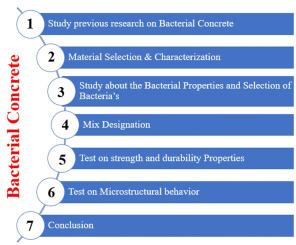Bacterial concrete: the future of self-healing and sustainable infrastructure
IF 1.9
Q2 MULTIDISCIPLINARY SCIENCES
引用次数: 0
Abstract
This study investigates the durability enhancement of bacterial concrete incorporating microbial strains (Bacillus Licheniformis, Bacillus Flexus, Pseudomonas stutzeri, Escherichia coli, and Bacillus subtilis) through microbial-induced calcium carbonate precipitation (MICP). Various durability tests, including water absorption, RCPT, sulphate resistance, hydrochloric acid strength loss, sorptivity, and energy-dispersive X-ray analysis (EDAX), were conducted to evaluate the effectiveness of bacterial concrete. Bacterial concrete significantly reduces water absorption and chloride ion penetration, with Bacillus subtilis (M16) and Bacillus Flexus (M7) demonstrating the highest impermeability. Sulphate resistance analysis confirmed reduced weight loss before and after healing, highlighting microbial self-healing capabilities. Hydrochloric acid strength loss and sorptivity tests further validated improved acid resistance and reduced capillary absorption. EDAX analysis confirmed the formation of calcium carbonate, contributing to matrix densification and enhanced durability. Overall, microbial concrete exhibited superior resistance to environmental degradation, with Bacillus subtilis, Bacillus Flexus, and Bacillus Licheniformis at higher concentrations (106 cells/ml) providing the most significant improvements.
Bacterial concrete showed increased workability and notable compressive, flexural, and split tensile strengths with Bacillus subtilis and Bacillus licheniformis at 10⁶ cells/mL,
Bacterial concrete provide the best self-healing and strength recovery capability; SEM and XRD data revealed higher density and effective crack healing.
Bacterial concrete is a sustainable material since it provides long-term durability by means of inherent self-healing systems.

细菌混凝土:自我修复和可持续基础设施的未来
本研究探讨了微生物菌株(地衣芽孢杆菌、弯曲芽孢杆菌、假单胞菌、大肠杆菌和枯草芽孢杆菌)通过微生物诱导的碳酸钙沉淀(MICP)增强细菌混凝土的耐久性。通过各种耐久性测试,包括吸水率、RCPT、硫酸盐抗性、盐酸强度损失、吸附性和能量色散x射线分析(EDAX),来评估细菌混凝土的有效性。细菌混凝土显著降低了吸水率和氯离子渗透性,枯草芽孢杆菌(M16)和弯曲芽孢杆菌(M7)表现出最高的抗渗性。硫酸盐抗性分析证实,愈合前后体重减轻,突出了微生物的自我修复能力。盐酸强度损失和吸附性测试进一步证实了其耐酸性能的提高和毛细吸收的降低。EDAX分析证实了碳酸钙的形成,有助于基体致密化和增强耐久性。总体而言,微生物混凝土表现出优异的环境降解抗性,其中枯草芽孢杆菌、弯曲芽孢杆菌和地衣芽孢杆菌在较高浓度(106个细胞/ml)下的改善最为显著。当枯草芽孢杆菌和地衣芽孢杆菌浓度达到10 26个细胞/mL时,细菌混凝土的和易性显著提高,抗压、弯曲和劈裂抗拉强度显著提高,具有最佳的自愈和强度恢复能力;SEM和XRD数据显示,该材料具有较高的密度和有效的裂纹愈合效果。细菌混凝土是一种可持续的材料,因为它通过固有的自我修复系统提供了长期的耐久性。
本文章由计算机程序翻译,如有差异,请以英文原文为准。
求助全文
约1分钟内获得全文
求助全文
来源期刊

MethodsX
Health Professions-Medical Laboratory Technology
CiteScore
3.60
自引率
5.30%
发文量
314
审稿时长
7 weeks
期刊介绍:
 求助内容:
求助内容: 应助结果提醒方式:
应助结果提醒方式:


